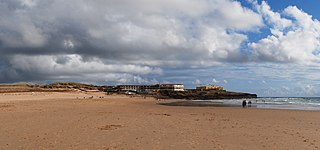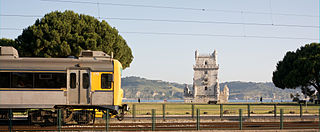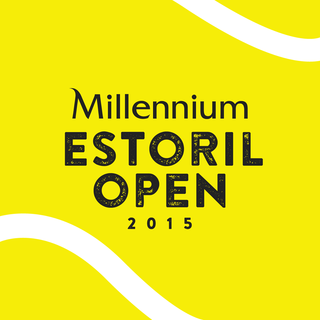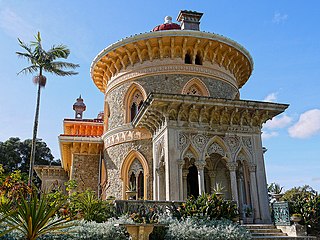
Estoril is a town in the Municipality of Cascais, Portugal, on the Portuguese Riviera. It is famed as a major international luxury tourist entertainment destination, and is known for its luxury hotels, beaches, and the Casino Estoril. Famed for having been home to numerous royal families and famous personalities, the town is also known for hosting numerous notable events, such as the Estoril Open and the Lisbon & Estoril Film Festival.

Cascais is a town and municipality in the Lisbon District of Portugal, located on the Portuguese Riviera. The municipality has a total of 214,158 inhabitants in an area of 97.40 km2. Cascais is an important tourist destination. Its marina hosts events such as the America's Cup and the town of Estoril, part of the Cascais municipality, hosts conferences such as the Horasis Global Meeting.

Oeiras is a town and municipality in the western part of Lisbon metropolitan area, located within the Portuguese Riviera, in continental Portugal. The municipality is part of the urban agglomeration of Lisbon and the town of Oeiras is about 16 km from Lisbon downtown. The population in 2011 was 172,120 living in an area of 45.88 km2, making the municipality the fifth-most densely populated in Portugal.

The Portugal Open was an ATP and WTA clay court tennis tournament in Portugal. The event took place at the sports complex of Jamor in Oeiras, of which Estoril Court Central is the most prominent show court. In 2015, the tournament was canceled due to lack of sponsorship. A new tournament, Millennium Estoril Open, was created in its place, moving from Oeiras to Cascais. The 2014 Portugal Open was the last edition.

Praia do Guincho is a popular Atlantic beach located on Portugal's Estoril coast, 5 km from the town of Cascais, and is located in the municipality of Cascais, more precisely in the parishes of Cascais and Alcabideche, in the District of Lisbon. Guincho is situated close to several small villages, including Areia, Charneca, Figueira do Guincho and Biscaia.

The Cascais Line is a Portuguese railway line which connects the municipalities of Lisbon, Oeiras, and Cascais. The line starts in Lisbon, at Cais do Sodré and ends in Cascais. On the Lisbon urban trains' diagram it is shown in yellow. The first section, from Cascais to Pedrouços, was opened in 1889. The line was completed in 1895. It was the first heavy rail line to be electrified in Portugal, in 1926, and the last to be integrated into CP, in 1977. In July, 2020, CP announced that the line is slated to be converted from 1500 V DC electrification, to 25 V AC, to match the rest of the network. Signalling will also be upgraded and new trains acquired.

The Associação de Radioamadores da Linha de Cascais, aka ARLC and Cascais Amateur Radio Association, was founded on 28 December 2011 to promote ham radio activity especially for youngsters, unite all amateurs, work with emergency authorities, and to support amateur radio and science investigation.

2007 ISAF Sailing World Championships was the second edition of the ISAF Sailing World Championships and was held in Cascais, Portugal on the Portuguese Riviera from 28 June to 13 July.

The Estoril Open is an ATP clay court tennis tournament held in the Portuguese Riviera. The event take place at the sports complex of Clube de Ténis do Estoril in Cascais. The tournament was created in 2015 to replace the historic Portugal Open, which was canceled due to lack of sponsorships. The tournament was created by former Dutch tennis player Benno van Veggel and Portuguese football agent Jorge Mendes.
The 2015 Estoril Open was a tennis tournament played on outdoor clay courts. The 2015 tournament was the first edition of the Estoril Open, and part of the ATP World Tour 250 series of the 2015 ATP World Tour. The event took place at the Clube de Ténis do Estoril in Cascais, Portugal, from April 25 through May 3, 2015.

Courtney Conlogue is an American professional surfer. She was born in Santa Ana, California. Courtney learned to surf at the age of 4. In 2004 when she was 11, Conlogue was the youngest athlete to be selected to the USA Junior Surf Team. She went on to achieve 11th place in the 2005 ISA World Junior Surfing Championships. By the time she was 14, she had won a surfing gold medal as a member of the U.S. Team in the X Games. When she was 17 she won the biggest competition in the US at the Hurley U.S. Open of Surfing, held at her home break in Huntington Beach, California.

Johanne Defay is a French professional surfer. She was born in Le Puy-en-Velay, Auvergne, France. She began surfing at the age of 8 off the beaches of Reunion Island, which is her home today. After Johanne's first competition when she was only ten years old, she quickly moved through the European amateur ranks to eventually take on the WSL World Qualifying Series. In 2008 Defay almost gave up competing. She was finding it difficult to transition from the juniors to the WQS and then the economy crashed causing many surf companies cancel their sponsorships. At that time, Johanne found herself without sponsors and also without decent results. However, with her parents’ encouragement, Johanne was able to qualify for the World Championship Tour within two years.

The Portuguese Riviera is the affluent coastal region to the west of Lisbon, Portugal, centered on the coastal municipalities of Cascais, Oeiras and Sintra. It is coterminous with the Estoril Coast and occasionally known as the Costa do Sol. The region is internationally known as a luxury destination for its history as a home of the wealthy, the famous, and European royalty. Cascais, Oeiras and Sintra municipalities consistently rank among the richest municipalities in Portugal.

The Santa Marta Lighthouse is situated to the south of the centre of Cascais, Lisbon District, Portugal, on the estuary of the River Tagus, providing a light for the Cascais Bay and for the town's new marina. It is a quadrangular masonry tower covered with white tiles, with blue horizontal stripes and a red lantern. The lighthouse was built on the grounds of the Santa Marta Fort, which now houses a lighthouse museum.

The Citadel of Cascais is a set of fortifications built between the 15th and 17th centuries to defend the Cascais coastline and River Tagus estuary and to protect against attacks on the capital of Portugal, Lisbon. The citadel incorporates three separate developments, the tower of Santo António de Cascais, the Fortress of Our Lady of Light, and the former Royal Palace area.

The Cascais Marina, in Cascais, Portugal, is the largest marina on the Portuguese Riviera and the third largest marina in the country.

The Museum of Portuguese Music is a small museum housed in the Casa Verdades de Faria in Estoril, municipality of Cascais, Portugal, on the Portuguese Riviera. It contains a collection of Portuguese musical instruments and other items, as well as a music documentation centre, and is also used for recitals.

The Fort of Saint Anthony of Barra is located overlooking the sea, in the parish of Estoril, Cascais municipality, District of Lisbon, in Portugal. It is sometimes known as the Old Fort ), or as the Fort of Salazar as it was used by the Prime Minister, António de Oliveira Salazar as his seasonal residence during the Portuguese dictatorship. Until early 2018 the fort had been disused and subject to some vandalism, but it was then restored by the Municipality and opened for public viewing for the first time on April 25, 2018.

Summer architecture was a Portuguese architectural movement originating in the Portuguese Riviera, in late 19th and early 20th century, when the region became a popular resort destination for the Portuguese Royal Family and the Portuguese aristocracy. The movement is not characterized by any single architectural style or artistic school, but rather unified by common themes, including leisure, wellness, exoticism, and heterotopia.

The Cascais Citadel Palace Museum is situated inside the grounds of the Cascais Citadel, in Cascais, Lisbon district, Portugal. Formerly the residence of the governor of the citadel, it was refurbished for use as the summer residence of the Royal Family, which spent September there annually from 1870 until the assassination of King Dom Carlos in 1908. It was subsequently used as one of the official residences of Portuguese presidents, but over time fell into neglect. After extensive restoration it was opened as a museum in 2011. The Palace forms part of the Museum of the Presidency of the Republic,, which has its headquarters at the Belém Palace in Lisbon.


















